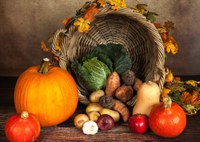Prairie Fare: Harvest nutrition this fall
(Click an image below to view a high-resolution image that can be downloaded)
Think back to what you ate yesterday or the day before yesterday. How many one-cup servings of vegetables did you eat?
Any kind of vegetables (corn, peas, beans, carrots) count. You can count two cups of raw leafy salad greens as one cup. You can count one cup of cooked beans (such as black beans or kidney beans) as one cup of vegetables.
Pause a bit and add up your total.
Next, let’s see how your total compares to the recommendations. Women ages 19 to 30 should aim for 2 ½ to 3 cups, and women 31 and older should aim for 2 to 3 cups of vegetables daily.
Men ages 19 to 59 should aim for 3 to 4 cups, while men ages 60 and older should aim for 2 ½ to 3 ½ cups of vegetables daily.
If you are eating the recommended amount or more, then pat yourself on the back. Only about one in 10 adults meets the recommended daily amount of vegetables.
Why eat plenty of veggies as part of an overall healthy diet? Vegetables are naturally low in calories and they provide fiber, vitamins and minerals that help us stay healthy and reduce our risk for diseases.
Eating more vegetables and fruit may reduce our risk for heart disease and help us manage our blood pressure. Eating plenty of vegetables and fruit) also can reduce our risk for certain kinds of cancer. The fiber in veggies can help promote digestive system health.
Fall is an ideal time to enjoy colorful vegetables fresh or to preserve them safely. We at NDSU Extension have lots of materials to help with preparation, canning, freezing and drying. Visit www.ag.ndsu.edu/food and go to “Preparation” then “Vary Your Veggies” or “Field to Fork/Garden to Table” to explore recipes. If you have more than you can eat right now, navigate to “Food Preservation” on the same site. Many NDSU county offices have printed copies available.
This recipe from the Centers for Disease Control and Prevention includes safe handling directions for each step. September is National Food Safety Education Month. Sweet potatoes and kale are an excellent source of beta-carotene, which our bodies convert to vitamin A. This vitamin keeps our skin, eyes, heart, lungs and other body systems healthy.
Fall Harvest Sweet Potato, Kale and Chicken Salad Recipe
Salad:
2 medium sweet potatoes
2 tablespoons olive oil (divided use)
1 pound boneless, skinless chicken breasts
½ teaspoon garlic powder (optional)
½ teaspoon onion powder (optional)
¼ teaspoon salt
¼ teaspoon ground black pepper
1 bunch of kale (or spinach or Romaine lettuce)
2 apples
1 cup chopped pecans
Salad dressing:
2 tablespoons red wine vinegar
1 tablespoon maple syrup
2 teaspoons Dijon mustard
½ teaspoon salt
½ teaspoon ground black pepper
¼ cup olive oil
Directions:
- Wash your hands with warm, soapy water for at least 20 seconds.
- Preheat your oven to 425 degrees Fahrenheit.
- Rinse and scrub sweet potatoes with running water (do not use produce washes or soap). Dry with a clean paper towel, then peel.
- Using a clean cutting board and knife, cut the sweet potatoes into 1-inch cubes.
- Place the sweet potato cubes into a baking dish with 1 tablespoon of olive oil and toss.
- Bake sweet potatoes for 10 minutes.
- Meanwhile, use a clean cutting board and knife to cut raw chicken breasts into 1-inch cubes (do not wash raw chicken).
- Wash your hands with warm, soapy water for at least 20 seconds after handling raw chicken.
- Add garlic powder, onion powder, salt, pepper, and 1 tablespoon of olive oil to a clean bowl.
- Add raw chicken to the bowl and toss with oil and spices.
- Wash your hands with warm, soapy water for at least 20 seconds.
- After the sweet potatoes have baked for 10 minutes, remove the baking dish from the oven, flip the sweet potatoes and add the chicken to the dish. Mix chicken and sweet potatoes together and place back in oven.
- Wash your hands with warm, soapy water for at least 20 seconds.
- Bake chicken and sweet potato mixture for around 20 minutes.
- Make the dressing by adding the red wine vinegar, maple syrup, Dijon mustard, salt, and pepper to a bowl and whisking them together. Slowly pour in olive oil, using the whisk to thoroughly combine the ingredients.
- Rinse apples and kale with running water (do not use produce washes or soap). Dry with a clean paper towel.
- Using a clean cutting board and knife, thinly slice the apple. Remove stems from kale and roughly chop it.
- Place kale in large bowl, add dressing, and toss with utensils.
- After baking chicken and sweet potatoes, check to make sure the internal temperature of the chicken is at least 165 degrees Fahrenheit. Use a food thermometer inserted into a few of the 1-inch cubes to check.
- Add chopped pecans, sliced apples, cooked sweet potatoes, and cooked chicken to the bowl with kale and dressing. Toss and serve.
- Refrigerate leftover salad within two hours of preparing it. If the salad is exposed to temperatures above 90 degrees Fahrenheit (like at a picnic), refrigerate it within one hour.
Makes five servings. Each main dish serving (with dressing) has 550 calories, 38 g fat, 25 grams (g) protein, 32 g carbohydrate, 7 g fiber and 583 milligrams sodium.
(Julie Garden-Robinson, Ph.D., R.D., L.R.D., is a North Dakota State University Extension food and nutrition specialist and professor in the Department of Health, Nutrition and Exercise Sciences.)
NDSU Agriculture Communication – Aug. 31, 2023
Source: Julie Garden-Robinson, 701-231-7187, julie.garden-robinson@ndsu.edu
Editor: Elizabeth Cronin, 701-231-7881, elizabeth.cronin@ndsu.edu




